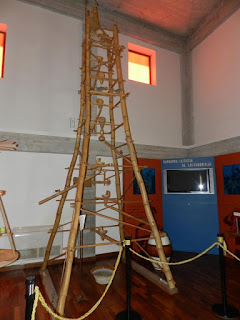Water and music in Carlos Blanco Fadol.
WATER AND MUSIC by Francisco Amós Tomás Pastor
Teaching at IES Miguel de Cervantes in Murcia, all music teachers in the region were invited to know a very special museum, a museum of musical instruments collected over more than 30 years and from all over the world. We were not disappointed by the visit, and although it was seven years ago, I have not missed the annual appointment with my students.
Ethnic Music Museum of Uruguayan Carlos Blanco Fadol ethnomusicologist located in Barranda in Caravaca de la Cruz (Murcia, Spain), is one of the most important museums in the world in its subject.
Carlos Blanco Fadol, is ethnomusicologist, anthropologist, adventurer, innovator, performer and researcher, and he has devised instruments relating them to water. Upon entering the museum of Barranda, we find a room where we see the "Busotaigua", in which the water moves two cylinders which in turn hits a xylophone and some bongos, performing "El Condor Pasa".
From the center of the ceiling of this room hangs an anchor chain. The building's architecture is designed so that when it rains, water runs off the chain producing a soft sound. The architect also adapted Charles White Fadol ideas such as collecting rainwater from the roof into the museum down a thick old boat chain to produce sounds, and the suggestion of the auditorium and stage pendants. And finally, in the same room, there is is a tower in which the water to run along it moves some instruments and balances driven by falling water when it rains. These instruments were invented by him, where the connection with nature, with a clear ecological component of "sustainable musical economy", to make the music speak more closely from nature.
The authorities in the region, and some famous people have visited the museum and found this water connection to the music, this new language of nature, simple and profound at the same time.
This intimate contact with nature is manifested in the search of the sounds produced ancient indigenous peoples, who have now lost. There are people that respect the environment where ancient traditions and customs united life made instruments built for religious or social ceremonies. It's funny and exciting at the same time the documentary where Carlos Blanco returns to teach the indigenous Yaguas of Amazon to build instruments of their ancestors lost.
Just because of this, he deserves recognition and applause, although his work is immense, and his tireless struggle is for the recovery of ancient music. He was nominated for the 2006 Prince of Asturias Award and has been awarded many honors with interviews in Spanish and foreign journals and reviews of their work on websites around the world.
He has done promotion of Barranda Museum in other countries of Latin America. "In the world, music is an art expressed through movement harmonious and balanced sound that reflects a deep breath that connects us to the multiverse". So begins the voiceover interview with Carlos Blanco on a television Andes.
In the village of the Yagua (Amazon), Carlos Blanco is the meaning of life. I say this because I think it's where he's at home, where himself, which actually makes more intimate concern: the union of man with nature the rough the pure sounds of instruments built by the hand of rough and laborious Indians.
In the museum, along the school visit, we have the fortunate opportunity to play these instruments, the angklung, playing several musical pieces, as the anthem of the joy of Beethoven. We still remember with emotion our last visit.
Carlos Blanco Fadol uses his interviews to play the flute or any instrument of his museum, which, incidentally, are all operating. Also, listen to Carlos talking and playing in the museum is a unique opportunity to learn constantly. It is worth seeing the great Chinese drum Gu touched by him.
Where we can find valuable information is in the official website of the museum. Here you can take a virtual tour, explaining each of the floors of the building, its themes, pictures, comments to each of the rooms, visits schedules, activities, contacts, etc.. But it is in his personal website where you can find more information on their activities and projects for over 30 years. We read a comment on the page itself: "to hear the sound of the earth and pick up your music with your hands, discover the ancient roots of the spirit of the people." And entering we show icons that lead to media comments, images, world cultures, musical instruments, exhibitions, the museum, activities, lectures, concerts, and a brief overview of his life.
Many schools are taking advantage of the ability to have this museum so close to us. Many students already know, having gone into primary and then repeating the visiting school. Do not leave anyone indifferent, and unforgettable moments are memories, and photos or comments that recall this experience. Our center is well known, and can say it is a must activity to know the boys and girls studying in the IESO Sierra Almenara, chance we have well used, with preparatory classes on musical instruments of the orchestra and the world in general .
I wanted in this short article, tackling the subject of water in ancient music, and what better way to remember our Barranda museum. I thank Carlos Blanco Fadol and all those who make it possible to continue showing this museum, which is like a philosophy of life. Water is the source of inspiration, since personal passion for music has emerged a space to share with others, especially with young people, the sounds of water and nature.
Pastor Thomas Francisco Amós
is a professor of music IESO Sierra Almenara of Purias, Lorca, Murcia


Comentarios
Publicar un comentario